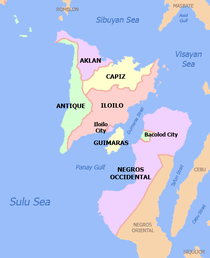Kalibo
| Kalibo | ||
|---|---|---|
| Municipality | ||
| Municipality of Kalibo | ||
 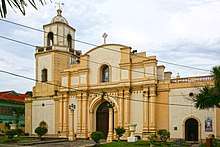  From top, left to right:
| ||
| ||
| Etymology: Calivo | ||
| Nickname(s): Ati-Atihan Town | ||
 Map of Aklan with Kalibo highlighted | ||
.svg.png) Kalibo Location within the Philippines | ||
| Coordinates: 11°42′N 122°22′E / 11.7°N 122.37°ECoordinates: 11°42′N 122°22′E / 11.7°N 122.37°E | ||
| Country |
| |
| Region | Western Visayas (Region VI) | |
| Province | Aklan | |
| District | 1st & 2nd Districts of Aklan | |
| Founded | 1949 | |
| Barangays | 16 (see Barangays) | |
| Government [1] | ||
| • Type | Sangguniang Bayan | |
| • Mayor | William S. Lachica | |
| • Vice Mayor | Madeline Regalado | |
| • Electorate | 46,096 voters (2016) | |
| Area [2] | ||
| • Total | 50.75 km2 (19.59 sq mi) | |
| Population (2015 census)[3] | ||
| • Total | 80,605 | |
| • Density | 1,600/km2 (4,100/sq mi) | |
| Demonym(s) | Kalibonhon | |
| Time zone | UTC+8 (PST) | |
| ZIP code | 5600 | |
| PSGC | 060407000 | |
| IDD : area code | +63 (0)36 | |
| Climate type | Tropical climate | |
| Income class | 1st municipal income class | |
| Revenue (₱) | 285,722,301.33 (2016) | |
| Native languages |
Aklan language Capiznon Tagalog | |
| Website |
www | |
Kalibo, officially the Municipality of Kalibo, (Aklanon: Banwa it Kalibo; Hiligaynon: Banwa sang Kalibo; Filipino: Bayan ng Kalibo), is a 1st class municipality and capital of the province of Aklan, Philippines. According to the 2015 census, it has a population of 80,605 people.[3]
Kalibo is located in the north-west of Panay. It is the main transportation hub for the resort island of Boracay. The municipality is known for the Ati-Atihan festival and for the semi-urban and multi-awarded mangrove forest, the Bakhawan Eco-Park.
Etymology
The term Kalibo comes from the Aklanon word sangkâ líbo, ("one thousand"), reputedly the number of native Ati who attended the first Catholic Mass celebrated there. Kalibo was originally spelled as Calivo.
The town of Kalibo was originally called Akean by the inhabitants, similar to the name of the river nearby. The word akean itself connotes the warbling of running waters, from the root word akae, meaning "to boil". Akae-akae means "to bubble" or "to boil" or "to make the sound of bubbling or boiling" in the Aklanon language.
The Spaniards interchanged the names Aklan and Calivo to refer to the town. Aside from these two, other names such as Calibo, Daclan, Adan, and Calibog have been used.
History
When Miguel Lopez de Legazpi arrived In 1569, he found the town had 2,000 so he recruited 500 to help conquer the rest of the Philippines. On November 3, 1571, it became an encomienda and on April 22, 1581 the town became a parish under the Augustinians. During the Spanish era, Kalibo was part of Capiz.
On March 23, 1897 the Nineteen Martyrs of Aklan were executed by the Spanish colonial government for their role in the Philippine Revolution.
The town was affected by World War II. On November 8, 1956, the province of Aklan was officially inaugurated and Kalibo became the capital.
Conversion to cityhood
During the early 21st century, Aklan congressman Florencio Miraflores filed a bill seeking to convert Kalibo into a city but this has yet to succeed.
The town was part of a decision by the Supreme Court of the Philippines on November 18, 2008, that granted a petition by the League of Cities of the Philippines (LCP) that the annulment of the cityhood status of the 16 towns whose cityhood bills were passed during the 11th Congress.
Geography
Kalibo is located at 11°42′N 122°22′E / 11.7°N 122.37°E.
According to the Philippine Statistics Authority, the municipality has a land area of 50.75 square kilometres (19.59 sq mi) [2] constituting 2.79% of the 1,821.42-square-kilometre- (703.25 sq mi) total area of Aklan.
Barangays
Kalibo is politically subdivided into 16 barangays, all classified as urban.[4] Mobo was formerly known as Tinigao Bongoe.[5]
| PSGC | Barangay | Population | ±% p.a. | |||
|---|---|---|---|---|---|---|
| 2015[3] | 2010[6] | |||||
| 060407001 | Andagaw | 15.8% | 12,703 | 12,607 | 0.14% | |
| 060407002 | Bachaw Norte | 2.9% | 2,336 | 2,031 | 2.70% | |
| 060407003 | Bachaw Sur | 3.9% | 3,131 | 2,688 | 2.95% | |
| 060407004 | Briones | 1.6% | 1,321 | 1,246 | 1.12% | |
| 060407005 | Buswang New | 12.9% | 10,431 | 9,231 | 2.35% | |
| 060407006 | Buswang Old | 4.0% | 3,247 | 2,420 | 5.76% | |
| 060407007 | Caano | 2.2% | 1,803 | 1,488 | 3.72% | |
| 060407008 | Estancia | 10.4% | 8,372 | 8,672 | −0.67% | |
| 060407009 | Linabuan Norte | 5.1% | 4,130 | 4,058 | 0.34% | |
| 060407010 | Mabilo | 3.0% | 2,378 | 2,298 | 0.65% | |
| 060407011 | Mobo | 1.9% | 1,543 | 1,939 | −4.26% | |
| 060407012 | Nalook | 4.1% | 3,323 | 2,879 | 2.77% | |
| 060407013 | Poblacion | 14.6% | 11,751 | 11,018 | 1.23% | |
| 060407014 | Pook | 7.1% | 5,744 | 5,010 | 2.64% | |
| 060407015 | Tigayon | 7.0% | 5,640 | 4,648 | 3.75% | |
| 060407016 | Tinigaw | 3.4% | 2,752 | 2,386 | 2.75% | |
| Total | 80,605 | 74,619 | 1.48% | |||
Demographics
| Population census of Kalibo | ||
|---|---|---|
| Year | Pop. | ±% p.a. |
| 1903 | 14,574 | — |
| 1918 | 13,926 | −0.30% |
| 1939 | 16,095 | +0.69% |
| 1948 | 17,842 | +1.15% |
| 1960 | 21,303 | +1.49% |
| 1970 | 30,247 | +3.56% |
| 1975 | 31,947 | +1.10% |
| 1980 | 39,894 | +4.54% |
| 1990 | 51,387 | +2.56% |
| 1995 | 58,065 | +2.32% |
| 2000 | 62,438 | +1.57% |
| 2007 | 69,700 | +1.53% |
| 2010 | 74,619 | +2.51% |
| 2015 | 80,605 | +1.48% |
| Source: Philippine Statistics Authority[3][6][7][8] | ||
In the 2015 census, Kalibo had a population of 80,605.[3] The population density was 1,600 inhabitants per square kilometre (4,100/sq mi).
Language
Aklanon is the main language of Kalibo. Hiligaynon and Capiznon were also spoken as secondary languages of the municipality, mostly for communicating with peoples from Capiz and Iloilo.
Economy
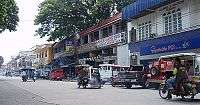
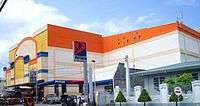
Kalibo's main industry is agriculture based on rice, coconuts and the Piña and Abaca cloths. Handbags made of buri leaves are also part of the exports.
Fabric from the town was used during the 1996 of APEC Summit in the Philippines, when world leaders donned a pineapple silk Barong Tagalog during the obligatory photo.
Kalibo also has a meat-processing industry that produces chorizo, tocino and other meat products.
Tourism in Kalibo peaks during the Ati-Atihan Festival, celebrated on the second week of January culminating on the third Sunday.
Culture
Ati-Atihan festival

The Ati-Atihan is a festival celebrated in Kalibo every second week of January and culminating on the 3rd Sunday of the month. Revelers smear themselves with soot or any blackening substance in order to look like an Ati.
Ati-Atihan is believed to have started in the year 1212 when Borneans led by the ten Datus traversed in several baeangays and crossed the Sulu Sea to land in Panay; making it the Oldest Festival in the Philippines.
Ati-atihan Festival was included as one of the "World's Best Festivals" by Fest300,[9] dubbed as the "Grand Daddy of Philippine Festivals" by the Largest Travel Guide Book Publisher in the World - Lonely Planet and recognized as the "Mother of All Philippine Festivals".[10]
Attractions
Landmarks of the town include Aklan river, the main river that flows in the town and the origin of the name of the province. Within the town proper lies Freedom Shrine which commemorates World War II veterans and the Museo it Akean, a museum of history. Outside the town lies Bakhawan Eco-Park, a 220-hectare (540-acre) mangrove reforestation project that began in 1990 in barangay New Buswang. Tigayon Hill and Cave in Barangay Tigayon, Kalibo was a burial site during the pre-Hispanic era and a pit of Chinese artifacts.
List of Historical Markers Installed by the National Historical Commission of the Philippines in Kalibo
| Marker Title | Description | Date Issued | Location |
|---|---|---|---|
Patriot Defender of Liberty and Leader of the Aklan Revolutionists |
1952 |
Pastrana Park (Poblacion) | |
Nineteen Martyrs of Aklan and Aklan Freedom Shrine |
Filipino Patriots in Kalibo, Aklan |
1952 |
Acevedo Building (Poblacion) and D. Maagma cor Veterans’ Avenue (Poblacion) |
1964 |
Glowmoon Hotel (Poblacion) | ||
28th Archbishop of Manila, and the first native Filipino to hold that post |
CAP Building (Poblacion) | ||
One of the Aklanon Heroes of World War II |
2006 |
Kalibo Police Station Building (Poblacion) | |
One of the Aklanon Heroes of World War II |
2006 |
Camp Pastor Martelino (New Buswang) | |
Filipino Commander during World War II |
2013 |
Provincial Capitol Site (Estancia) | |
Transportation
Air
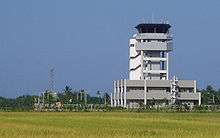
Air travel to Kalibo from Manila is about 45 minutes under four airlines: the Philippine Airlines, Cebu Pacific, AirAsia Zest and PAL Express. These airlines increase their flights during the Kalibo Ati-Atihan Festival in January.
PAL Express also flies to Cebu and Angeles. AirAsia Philippines and SeaAir also have flights to Angeles. AirAsia has a flight to Kuala Lumpur. Meanwhile, Mandarin Airlines, TransAsia Airways, China Southern, China Airlines have weekly flights to and from Taipei; Philippine Airlines and Shanghai Airlines have chartered flights to and from Shanghai; Jin Air does flights to Incheon. Spirit of Manila has its chartered flight to Kalibo from its regional destinations. Zest Air have flights to Seoul, Busan, Shanghai, Taipei, Beijing, and Chengdu. Philippine Airlines has flights to Hong Kong and Seoul.
Kalibo is the major hub for to Boracay. The Kalibo International Airport is about ten minutes from the main plaza.
Sea
Kalibo has four ports near the town. The New Washington port and the Dumaguit port are 20 minutes away from Kalibo. Batan port is accessible via Dumaguit and Altavas while the Malay port is approximately two hours. Travel time from Manila to Aklan is 14 to 18 hours through sea travel.
The Caticlan Jetty Port is part of the Roll-on Roll-off (RORO) Strong Republic Nautical Highway that connects Luzon, Visayas and Mindanao, and it passes through Kalibo to Capiz or Romblon. There is a jetty port in barangay Pook of Kalibo.
Land
Public transportation around the town is by tricycle, taxi, multicab and jeepneys.
Kalibo is 158 kilometres (98 mi) from Iloilo City, 86 kilometres (53 mi) from Roxas City, and 182 kilometres (113 mi) from San Jose, Antique. Land travel from Iloilo City to Kalibo takes approximately three hours, one and a half hours from Roxas City, and four hours from San Jose, Antique. All are accessible by bus and minivans. Trips to Caticlan range from 70 minutes to 90 minutes depending on the mode of transportation.
Public transport
The tricycle dominates the streets in Kalibo and is the main form of public transport. The town has its own version of the design of its tricycle that can accommodate up to 8 passengers. The design was also adopted in of the rest of Aklan and some parts of northern Antique. There are about 3,500 tricycles that are registered for public transportation and they are distributed in the following routes:
| Route No. | Color code | Coverage | Terminal | |
|---|---|---|---|---|
| 1 | Green |
|
Kalibo Public Market | |
| 2 | Blue |
|
RC Supermart; Gaisano (to Andagao) | |
| 3 | Orange |
|
Allen's Mart. | |
| 4 | White & | Purple |
|
None |
| Note: All the terminals are along Toting Reyes Street (except that of Going to Andagao) | ||||
International relations
Kalibo has one official sister city:
References
- ↑ "Municipality". Quezon City, Philippines: Department of the Interior and Local Government. Retrieved 31 May 2013.
- 1 2 "Province: Aklan". PSGC Interactive. Quezon City, Philippines: Philippine Statistics Authority. Retrieved 12 November 2016.
- 1 2 3 4 5 Census of Population (2015). "Region VI (Western Visayas)". Total Population by Province, City, Municipality and Barangay. PSA. Retrieved 20 June 2016.
- ↑ "Municipal: Kalibo". PSGC Interactive. Quezon City, Philippines: Philippine Statistics Authority. Retrieved 8 January 2016.
- ↑ "Republic Act No. 715 - An Act Changing the Name of the Barrio Tinigao Bongoe, Municipality of Kalibo, Province of Capiz, to Mobo". Chan Robles Virtual Law Library. 6 June 1952. Archived from the original on 27 September 2013. Retrieved 20 October 2016.
- 1 2 Census of Population and Housing (2010). "Region VI (Western Visayas)". Total Population by Province, City, Municipality and Barangay. NSO. Retrieved 29 June 2016.
- ↑ Censuses of Population (1903–2007). "Region VI (Western Visayas)". Table 1. Population Enumerated in Various Censuses by Province/Highly Urbanized City: 1903 to 2007. NSO.
- ↑ "Province of Aklan". Municipality Population Data. Local Water Utilities Administration Research Division. Retrieved 17 December 2016.
- ↑ "Ati-Atihan". Fest300. Archived from the original on 2 April 2016. Retrieved 20 October 2016.
- ↑ Lizares, Luci (20 January 2014). "History of Sto. Niño Festivals". Sun.Star Bacolod. Archived from the original on 28 January 2016. Retrieved 20 October 2016.
The Ati-Atihan festival is called the Mother of all Filipino festivals.
- ↑ "Juneau's Sister Cities". City and Borough of Juneau. Archived from the original on 5 March 2016. Retrieved 20 October 2016.
External links
| Wikimedia Commons has media related to Kalibo. |

